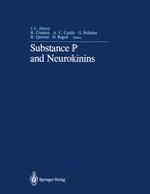1987 | OriginalPaper | Chapter
Conformationally Restricted Analogues of Substance P
Authors : O. Ploux, S. Lavielle, G. Chassaing, S. Julien, A. Marquet, J-C. Beaujouan, Y. Torrens, L. Bergström, J. Glowinski
Published in: Substance P and Neurokinins
Publisher: Springer New York
Included in: Professional Book Archive
Activate our intelligent search to find suitable subject content or patents.
Select sections of text to find matching patents with Artificial Intelligence. powered by
Select sections of text to find additional relevant content using AI-assisted search. powered by
The three-dim-nsional structure of a peptide deduced from conformational analyses (nuclear magnetic resonance and circular dichroism spectroscopies) and/or from energy calculations should provide an insight into the structural requirements of the binding protein, if this structure has any relevance to the conformation which interacts with the binding protein. A decisive contribution to overcome this problem has been the design of constrained analogues of the peptide which simulate the predicted conformers. Indeed such rigidified analogues, if active, must contribute to a more accurate description of the bioactive conformation[l]. We have established, using NMR and CD spectroscopies, that the three-dimensional structure of SP is strongly influenced by its environment. The main features of the conformation model we have proposed are the flexibility of the N-terminal Arg-ProLys, the a-helical folding of the core of SP, Pro-Gln-Gln-Phe-Phe, and the folding of the C-terminal carboxamide towards the primary amides of Gin5 and Gln6 [2] The validity of this model has been checked by the means of constrained cyclic analogues of SP. Therefore, we have synthesized two groups of disulfide bridged analogues of SP.
